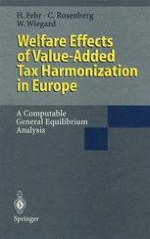1995 | OriginalPaper | Chapter
VAT Policy Options for an Integrated Europe
Authors : Dr. Hans Fehr, Dr. Christoph Rosenberg, Professor Dr. Wolfgang Wiegard
Published in: Welfare Effects of Value-Added Tax Harmonization in Europe
Publisher: Springer Berlin Heidelberg
Included in: Professional Book Archive
Activate our intelligent search to find suitable subject content or patents.
Select sections of text to find matching patents with Artificial Intelligence. powered by
Select sections of text to find additional relevant content using AI-assisted search. powered by
In this chapter we discuss the VAT policy options that are applicable in an integrated Europe. We distinguish between three broad policy options. The first presupposes that border controls have been abolished but that international tax barriers have been retained as far as possible. The current transitional VAT system, effective since January 1, 1993, operates in this way. Compliance costs aside, the economic effects of the transitional system depend heavily on the tax treatment of cross-border sales to final consumers. Our preferred interpretation is that either the destination or the origin principle be applied to intra-community sales to private persons whatever taxation principle is of mutual advantage for the vendor and the purchaser in different EU member states. We will call this the “switching option”. In contrast to this, the relevant literature seems to assume that all cross-border sales to final consumers are taxed according to the origin principle under the transitional system. According to this interpretation, the current situation is described as a “mixed system”, taxing trade between registered taxpayers by the DP but applying the OP to cross-border sales to non-registered taxpayers.
